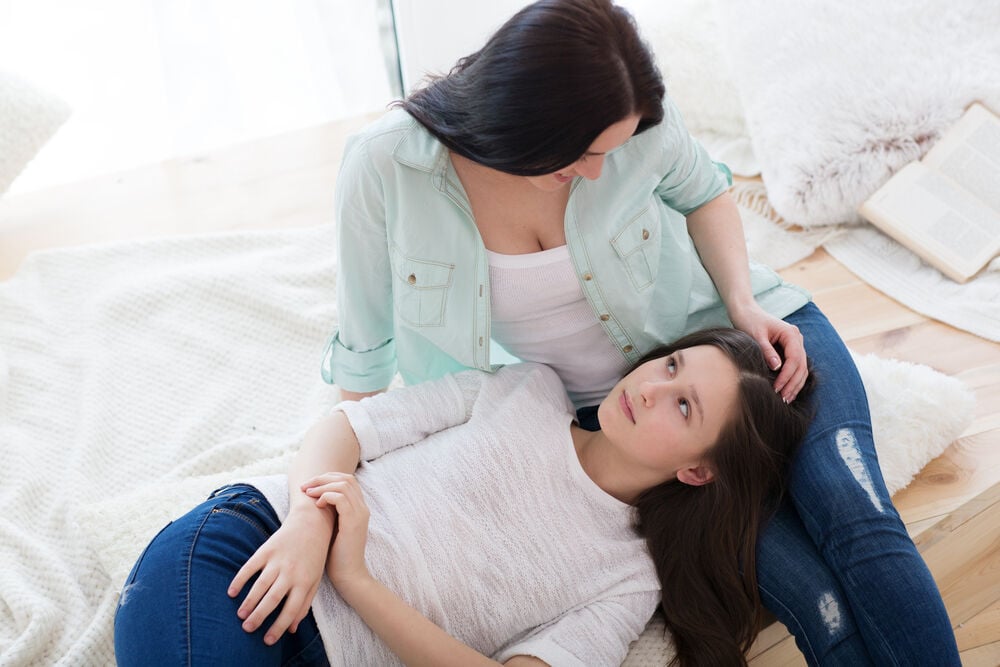The first menstrual period, which occurs during puberty, is known by the medical term menarche. Join Flo as we delve deeper into the physical subtleties of menarche, as well as common indications that a girl’s first period is approaching.
-
Tracking cycle
-
Getting pregnant
-
Pregnancy
-
Help Center
-
Flo for Partners
-
Anonymous Mode
-
Flo app reviews
-
Flo Premium New
-
Secret Chats New
-
Symptom Checker New
-
Your cycle
-
Health 360°
-
Getting pregnant
-
Pregnancy
-
Being a mom
-
LGBTQ+
-
Quizzes
-
Ovulation calculator
-
hCG calculator
-
Pregnancy test calculator
-
Menstrual cycle calculator
-
Period calculator
-
Implantation calculator
-
Pregnancy weeks to months calculator
-
Pregnancy due date calculator
-
IVF and FET due date calculator
-
Due date calculator by ultrasound
-
Medical Affairs
-
Science & Research
-
Pass It On Project New
-
Privacy Portal
-
Press Center
-
Flo Accuracy
-
Careers
-
Contact Us
Menarche: Key Facts About Your Daughter’s First Period


Every piece of content at Flo Health adheres to the highest editorial standards for language, style, and medical accuracy. To learn what we do to deliver the best health and lifestyle insights to you, check out our content review principles.
What is menarche?
The onset of menstruation is essentially the most straightforward menarche definition available. Pronounced “MEH-nar-kee,” menarche is not a widely known term for the first menstrual period, and is sometimes misspelled as menarch or menarchy.
Before your daughter gets her first period, you’ll probably notice other signs of puberty, such as breast development.
Why is menarche important?
Many consider a girl’s first period to be an official first step towards womanhood. A lot of women distinctly remember their first menstrual period as a monumental moment in their young lives.
What is menstruation?
Menstruation is a complex process during which your uterus sheds the lining of its inner wall. Every month, your body prepares itself for a possible pregnancy. Getting your period basically means that you are not pregnant.
Throughout the monthly menstrual cycle, your body uses two hormones (estrogen and progesterone) to thicken your uterine lining. Composed of blood and tissue, it is crucial in assisting with the process of egg fertilization. If you don’t become pregnant, your body no longer needs this lining and starts to break it down and expel it through your vagina.
Take a quiz
Find out what you can do with our Health Assistant
Average age of a girl’s first period
On average, the menarche age for girls in the U.S. is around 12 or 13 years. The standard age range for menarche is between 11 and 15. However, young women can also experience early menarche (i.e., before 11 years) or delayed menarche (i.e., after 16 years).
Causes of early menarche
Some scientists speculate that increases in body weight during childhood account for the early onset of menarche. Early menarche is a symptom of precocious puberty, which could be the result of:
- Ethnic background and predisposition (i.e., certain groups are more prone to early menarche)
- Central nervous system abnormalities
- Rare genetic syndromes
- Tumors of the brain, pituitary gland, or ovaries
- Adrenal gland disorders
- Severe hypothyroidism
Causes of delayed menarche
In contrast, delayed menarche is often attributed to a lack of body fat. Your body requires adequate amounts of fat to enter the phase of puberty and trigger your first menstrual period.
That’s why hard-core athletes, such as swimmers, dancers, and gymnasts, who tend to carry less body fat, are more susceptible to delayed menarche. Additionally, young women struggling with eating disorders appear vulnerable to this as well.
Other possible causes of delayed menarche include:
- Genetic predisposition (e.g., delayed menarche often runs in the family)
- Health issues such as inflammatory bowel diseases (IBD), anemia, diabetes mellitus, kidney disease, and cystic fibrosis
- Radiation or chemotherapy treatment
- Autoimmune disorders (e.g., Addison’s disease and Hashimoto’s thyroiditis)
- Tumors of the pituitary gland or hypothalamus, which affect hormone production
Signs of a girl’s first period

Like your daughter, you probably wondered at some point, “When will I get my first period?” Their first menstrual period signals the start of the next stage of life and is a really exciting time. But, it can also be a bit nerve-wracking. Be prepared to have an open conversation about it and remember to be on the lookout for the signs of their first period.
Young women usually undergo initial breast development roughly two years prior to menarche. They may take several years to grow and will start out as “breast buds.” Other signs of puberty include hair growth in the underarms and pubic area.
Lastly, before her first period, your daughter will notice thick, liquid-like vaginal discharge that’s white, clear, or yellowish in color. It’s perfectly normal and helps the vagina to clean itself and fight off infections. Note that vaginal discharge should be odorless ‒ a strong odor could mean a urinary tract infection.
What to do after the first menstrual period
If your daughter’s first menstrual period shows up unexpectedly and there are no sanitary pads on hand, she can temporarily use folded-up toilet paper. If you’re not with her when it happens, it’s OK to ask a teacher, the school nurse, or a friend for one.
It’s best for beginners to avoid tampons until they’ve read the instructions thoroughly and practiced a few times. Try to have a discussion with your daughter about it to familiarize her with the way they work.
It’s essential to change a pad every four to six hours to prevent bacterial growth and infection.
A girl’s first period will generally last a few days, so she’ll need to stash several pads in her purse or backpack. Remind her that it’s essential to change her pad every four to six hours to prevent bacterial growth and infection.
Lastly, remember to take note of the date that her first menstrual period began so you can both be better prepared for next month. Keeping track also allows you to detect irregular periods, which are especially common during puberty.
Tips for managing a girl’s first period
Share the following tips with your daughter when menarche arrives so she can learn to manage menstruation and its associated symptoms:
- Track periods with an app like Flo which helps you plan ahead.
- Carry sanitary pads or tampons at all times. (Save thin panty liners for lighter flow days, as menstruation winds down.)
- Expect lower back pain or abdominal pain, and consider using a hot water bottle to relieve achiness.
- Ease up on exercise and other strenuous physical activity.
- Drink plenty of water.
- Get a full eight hours of sleep each night to battle fatigue.
When to see a doctor
If your daughter doesn’t fall within the average age range for puberty and menarche, it could be a sign of other health concerns. It’s wise to take her to the doctor if she’s experiencing menarche before the age of 11, or if she’s displaying any of the following symptoms:
- Delayed menarche (i.e., absence of menstruation by the age of 16)
- Lack of breast development by the age of 13
- A gap of four years or more between initial breast growth and menarche
Takeaway
A young woman’s first menstrual period is called menarche. It represents an exciting turning point in your daughter’s life and will likely appear around the age of 12 or 13. Try to plan in advance the various ways you can offer support as she experiences her very first menstrual period and officially enters womanhood.


Hey, I'm Anique
I started using Flo app to track my period and ovulation because we wanted to have a baby.


The Flo app helped me learn about my body and spot ovulation signs during our conception journey.


I vividly
remember the day
that we switched
Flo into
Pregnancy Mode — it was
such a special
moment.
Real stories, real results
Learn how the Flo app became an amazing cheerleader for us on our conception journey.




